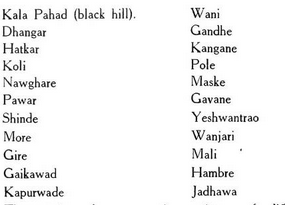Gopal: Deccan
Contents |
Gopal
This article is an extract from THE CASTES AND TRIBES OF H. E. H. THE NIZAM'S DOMINIONS BY SYED SIRAJ UL HASSAN Of Merton College, Oxford, Trinity College, Dublin, and Middle Temple, London. One of the Judges of H. E. H. the Nizam's High Court of Judicature : Lately Director of Public Instruction. BOMBAY THE TlMES PRESS 1920 Indpaedia is an archive. It neither agrees nor disagrees |
Gopal — a class of wandering athletes, acrobats, mat-makers and buffalo dealers, chiefly found in the northern parts of the Aurangabad District. •Ouring their wanderings, they live in huts of grass mats, which they carry with their goods and chattels on the backs of buffaoes.
Origin
They trace their origin to persons who were, in ancient times, dedicated to the god Kanhoba of Tisgaon Madhi, in the District of Ahmednagar, and were designated ' Bal-Gopals,' after one of the names of Krishna or Kanhoba. They are divided into : (1) Vira Gopal, (2) Pahilwan Gopal, and (3) Kam Gopal. The Vira Gopals resemble the Maratha Kunbis, live in huts of date palm leaves and earn their livelihood by making mats from the leaves of the date palm. The Pahilwan Gopals are acrobats, practising gymnastics and performing feats on a long pole, to the accompaniment of a torn torn, or circular drum. They also make mats of date palm leaves. The men wear tight drawers, while the women dress in the Maratha Kunbi fashion. There is one more division, known as Gujarati Gopals, who have, however, nothing in common with the above men- tioned sub-castes. The male members of this sub-caste wear tight white drawers, a large red or white turban and a coloured cloth over the shoulder. Unlike the other Gopal tribes, they wear necklaces of white beads and ear-rings of brass wire with white beads strung on the end. They earn their living by performing on the tight rope, tumbling and exhibiting other feats of strength on the ground, and by mat and basket making. They occupy the lowest social position among the Gopal tribes.
Internal Structure
The section names of the caste are as
follows : —
The sections show a curious mixture of different types "Yeshwantrao' appears to be the name of a man who may have been the eponymous founder of the Yeshwantrao section. Some of them, such as Hatkar, Koli, Mali, Wani, Dhangar and Wanjari, are doubt- less the names of castes from which the Gopal tribe was originally recruited. Others, such as Yeshwantrao, are purely eponymous in their character, being the names of persons who founded the section names, while the name 'Kala Pahad' (black hill) and others sinilar to it represent the territorial element among them. But, by far, the greater number of them have evidently been borrowed from the Maratha Kunbis.
Marriage
The Gopals observe the simple rule of exogamy that a man may not marry a woman of his own section. He may marry the daughters of his father's sister and of his mother's brother. Daughters are married either as infants or adults ; but, as by other wandering tribes, the latter usage is deemed the more convenient. Sexual intercourse before marriage is tolerated, but if a girl becomes pregnant, her lover is called upon to marry her. Polygamy is re- cognised, and a man may have as many wives as he can afford to maintain. The customary bride-price paid for a Gopal girl is Rs. 5. The marriage ceremony is of the Maratha type and needs no special description. A widow may re-marry and a wife may be divorced for adultery or for incurable ill-temper. Divorced wives may marry again in the same manner as widows.
Religion
In matters of religion, the Gopals differ very little from the- Maratha Kunbis. Their special deity is Kanhoba of Tisgaon Madhi, who is worshipped once a year with great pomp and cere- mony. For ceremonial and religious purposes, Brahmans are em- ployed by the members of the caste, who also revere the spirits of their dead ancestors.
Disposal of the Dead
The dead are buried in a sitting posture. The body is carefully washed, smeared with gulal (red powder) and borne to the grave swathed in a sheet of white cloth. The Sradha ceremony is performed on the 1 0th day after death and ancestors in general are propitiated twice a year, viz., on the Akshattitiya, which falls on the light third of Vaishakha, and on the Pitra AmaiOasya, the last day of Bhadrapad.
Social Status
Socially, the Gopals rank below the Maratha Kunbis, but far above the impure classes of Hindu society. They eat mutton, pork, fish, fowl and the flesh of hare, deer and the iguana, and drink spirituous and fermented liquors. They do not eat the leavings of other castes.
Occupation
In addition to their occupation as acrobats and rope-dancers, the Gopals deal in the milk of buffaloes. They have an evil reputation as inveterate robbers and their movements are vigilantly watched by the police.
